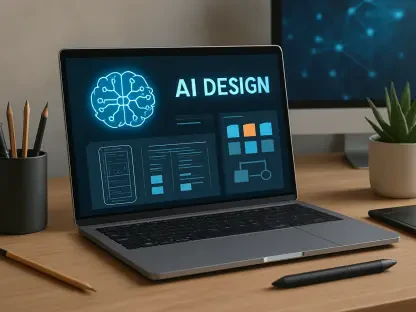In today’s fast-paced digital ecosystem, Software-as-a-Service (SaaS) platforms have become indispensable to businesses, driving efficiency and scalability across industries. Yet, with this widespread adoption comes a staggering statistic: over 80% of organizations using SaaS solutions have reported at least one security incident in the past year, underscoring a critical vulnerability in cloud-based environments. As cyber threats grow in sophistication, targeting user identities, devices, and data, the urgency to fortify SaaS security has never been greater. Enter artificial intelligence (AI), a transformative force poised to redefine how threats are detected and mitigated. This report delves into the intersection of AI and SaaS security, exploring its impact, challenges, and potential to create a safer digital landscape for enterprises worldwide.
Understanding the SaaS Security Landscape
SaaS platforms are now a cornerstone of modern business operations, offering unparalleled flexibility and cost-efficiency that enable companies to scale without the burden of extensive on-premises infrastructure. From startups to multinational corporations, organizations rely on these cloud-based solutions for everything from customer relationship management to collaborative tools, making SaaS an integral part of daily workflows. Major players like Salesforce, Microsoft, and Google dominate the market, yet the rapid proliferation of SaaS applications has introduced a complex web of security challenges that traditional measures struggle to address.
The scope of SaaS adoption spans diverse industries, including healthcare, finance, and retail, where sensitive data is frequently stored and accessed via the cloud. With this expansion, the attack surface has widened, exposing vulnerabilities in user authentication, data encryption, and endpoint protection. Cybercriminals exploit these gaps with advanced tactics, such as phishing and insider threats, rendering static security protocols insufficient. The growing complexity demands innovative approaches to safeguard critical assets and maintain operational continuity.
Emerging technologies, particularly AI, are reshaping the cybersecurity paradigm within SaaS environments. By leveraging machine learning and predictive analytics, AI offers a dynamic shield against evolving risks, moving beyond mere reaction to proactive defense. The significance of robust cybersecurity in SaaS cannot be overstated, as breaches can lead to substantial financial losses and reputational damage. This convergence of SaaS reliance and AI-driven innovation sets the stage for a deeper exploration of security transformation.
The Impact of AI on SaaS Security Strategies
Key Trends and Innovations in AI-Driven Security
AI is steering SaaS security away from reactive postures toward proactive, predictive frameworks that anticipate threats before they materialize. Traditional systems often respond only after an incident occurs, leaving gaps for exploitation. In contrast, AI empowers organizations to identify potential risks through continuous monitoring and pattern recognition, enabling preventive measures that halt attacks in their tracks.
Among the notable innovations are anomaly detection and behavioral analysis, which allow systems to pinpoint deviations from normal user or device activity. For instance, AI can detect unauthorized access attempts by analyzing login times and locations, flagging suspicious behavior for immediate action. Additionally, automated threat response mechanisms reduce reaction times by neutralizing risks without manual intervention, a critical advantage against fast-moving threats like ransomware.
These advancements are particularly effective against sophisticated cyberattacks targeting SaaS ecosystems, including those aimed at cloud infrastructure and user credentials. AI’s ability to process vast amounts of data in real time equips it to tackle complex threats that evade conventional tools. As a result, businesses gain a fortified defense layer that adapts to new attack vectors, ensuring resilience in an increasingly hostile digital environment.
Performance and Growth Prospects of AI in SaaS Security
The effectiveness of AI in bolstering SaaS security is evident in its capacity for real-time risk prediction, which significantly reduces the likelihood of breaches. By automating routine tasks such as log analysis and patch management, AI frees up IT resources for strategic initiatives, enhancing operational efficiency. Studies indicate that organizations using AI-driven security tools have experienced a marked improvement in threat detection rates compared to those relying on legacy systems.
Looking at growth projections, the adoption of AI in SaaS security is expected to surge over the coming years, with market analysts forecasting substantial investment increases from this year through 2027. This momentum is driven by tangible outcomes, including faster incident response and lower costs associated with breach recovery. The data underscores AI’s role as a catalyst for transforming security into a competitive advantage rather than a liability.
A forward-looking perspective reveals how AI integration could redefine security standards across key areas like Unified Endpoint Management (UEM), Access Management, and Compliance. In UEM, AI ensures devices comply with policies through continuous assessment, while in Access Management, it verifies identities with precision. For Compliance, AI streamlines adherence to regulations by automating audits, setting a new benchmark for SaaS protection that promises scalability and adaptability.
Challenges in Implementing AI for SaaS Security
Adopting AI-driven security solutions for SaaS platforms is not without hurdles, as technological limitations often pose significant barriers. Many organizations face difficulties integrating AI with existing systems, especially when dealing with outdated infrastructure that lacks compatibility. Such integration complexities can delay deployment and reduce the effectiveness of AI tools if not addressed systematically.
Beyond technical issues, privacy concerns loom large, as AI systems rely on extensive data collection to function optimally. The risk of mishandling sensitive information or inadvertently violating user rights is a pressing issue that demands careful consideration. Additionally, an over-reliance on automation without adequate human oversight can lead to errors, such as false positives in threat detection, potentially undermining trust in these systems.
To mitigate these challenges, a balanced approach is essential, combining AI capabilities with ethical guidelines to ensure responsible use. Investing in robust training for IT teams can bridge knowledge gaps, enabling staff to oversee AI operations effectively. Furthermore, fostering a culture of transparency around data usage helps address privacy worries, paving the way for smoother adoption while maintaining security integrity.
Regulatory and Ethical Considerations in AI-Driven Security
The regulatory landscape surrounding AI in SaaS security is intricate, shaped by stringent data protection laws and compliance standards that vary across regions. Frameworks like the General Data Protection Regulation (GDPR) impose strict requirements on how data is handled, compelling organizations to align AI practices with legal mandates. Non-compliance can result in hefty penalties, making it imperative to embed regulatory awareness into security strategies.
Transparency and accountability form the bedrock of ethical AI implementation, particularly in safeguarding user privacy. Stakeholders must have clarity on how AI systems process data and make decisions, fostering trust in automated mechanisms. Without such openness, there is a risk of alienating users who may perceive AI as intrusive, highlighting the need for clear communication about security protocols.
Establishing ethical frameworks is crucial to guide AI deployment in SaaS security, ensuring that automation enhances rather than compromises reliability. These guidelines should prioritize fairness and minimize bias in AI algorithms, addressing potential disparities in threat detection. By adhering to ethical principles, businesses can build confidence in AI systems, reinforcing their role as trusted tools in the fight against cybercrime.
Future Horizons: AI’s Potential in SaaS Security
Envisioning the trajectory of AI in SaaS security reveals a landscape of self-adjusting and self-remediating platforms that operate with minimal human input. Such systems could autonomously update defenses in response to emerging threats, reducing downtime and enhancing protection. This level of independence represents a significant leap from current capabilities, promising a future where security is seamlessly integrated into operations.
Potential advancements include dynamic access policies that adapt based on real-time risk assessments, ensuring only authorized users gain entry under specific conditions. Another area of innovation lies in phishing detection, where AI could analyze behavioral cues to identify fraudulent communications with greater accuracy. These developments aim to balance robust security with a frictionless user experience, a critical factor for widespread SaaS adoption.
Global cybersecurity trends and evolving threats will continue to influence AI’s role in SaaS security, pushing for continuous innovation. As attackers refine their methods, AI must evolve to counter tactics like deepfake-enabled scams or zero-day exploits. The ongoing interplay between threat sophistication and AI advancement will shape a resilient security framework, preparing SaaS environments for challenges yet to emerge.
Conclusion: Shaping a Secure SaaS Ecosystem with AI
Reflecting on the insights gathered, it becomes clear that AI plays a pivotal role in transforming SaaS security from static defenses to intelligent, adaptive systems. The journey highlights a shift that empowers businesses to anticipate and neutralize threats with unprecedented precision. This evolution marks a significant milestone in addressing the vulnerabilities inherent in cloud-based platforms.
Looking back, the balance between AI automation and human oversight stands out as a critical factor in ensuring ethical and effective implementation. The discussions underscore that while technology advances rapidly, the human element remains indispensable for accountability. This synergy is deemed essential for navigating the complexities of modern cybersecurity.
As a forward-looking step, organizations are encouraged to prioritize responsible AI adoption by investing in comprehensive training and ethical guidelines. Collaboration between industry leaders and policymakers is seen as vital to establish standards that protect user privacy while fostering innovation. By embracing these measures, the path is paved for a safer digital landscape, ensuring that SaaS-dependent businesses can thrive in an era of intelligent security solutions.









